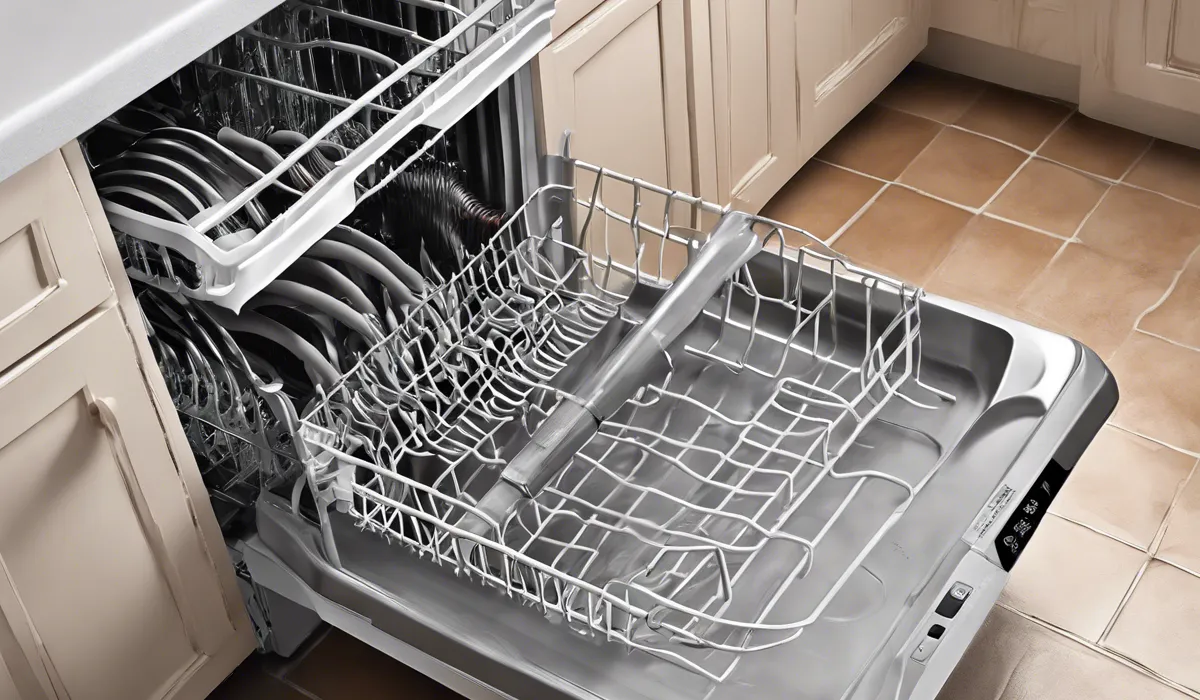How to Change Dishwasher Drain Hose: Quick DIY Fix!
To change a dishwasher drain hose, turn off the power and water supply, then remove the toe-kick panel. Disconnect the old hose from the drain and dishwasher, then attach the new hose, securing it with clamps. Reassemble and test for leaks.
Step-by-Step Guide to Changing the Dishwasher Drain Hose

Turn off the Power and Water Supply
Before starting any maintenance on your dishwasher, safety is paramount. Begin by shutting off the power supply to your dishwasher at the circuit breaker. This will prevent any electrical accidents.
Similarly, turn off the water supply valve to avoid any potential water issues. This precaution ensures a safe working environment as you proceed to change the drain hose.
Empty the Dishwasher
Clear out any dishes or utensils from your dishwasher. This step is crucial for two reasons. Firstly, it prevents any items from being damaged during the repair process.
Secondly, it allows easier access to the components you’ll be working on, including the drain hose. An empty dishwasher also means less weight, making it more manageable if you need to move it.
Remove the Toe-Kick Panel and Lower Front Panel
With a screwdriver, remove the toe-kick panel located at the bottom front of the dishwasher. This will expose the lower front panel.
Carefully remove this panel as well to gain full access to the dishwasher’s underside where the drain hose is typically located. Keep the screws and panels in a safe place for reassembly later.
Locate the Drain Hose Connection
Look for the drain hose connection, which is usually found under the kitchen sink or attached to the air gap. Identifying the connection point is essential for the proper detachment and installation of the new hose.
Disconnect the Old Drain Hose
Using pliers, loosen the hose clamps that secure the drain hose to the dishwasher and the sink or air gap.
Have a bucket and towels ready to catch any residual water that may spill from the hose once it is disconnected. Remove the old hose carefully to avoid any unnecessary water damage.
Prepare the New Drain Hose for Installation
Before installing the new drain hose, check if it’s the correct type and size for your dishwasher model. If required, use Teflon tape on the threads to ensure a watertight connection.
Ensure that the new hose is flexible enough to reach without kinking or bending sharply, which could impede water flow.
Attach the New Hose to the Dishwasher
Slide one end of the new drain hose onto the dishwasher’s drain outlet. Secure it with a hose clamp by tightening it with the pliers or hose clamp tool. Make sure the fit is snug to prevent any potential leaks.
Secure the New Hose to the Sink or Air Gap
Take the other end of the new hose and attach it to the under-sink plumbing or the air gap. Again, use a hose clamp to secure the connection. Ensure that the hose is routed properly to prevent kinking, which could block the flow of water.
Test for Leaks
Once everything is connected, turn on the water supply and power to the dishwasher.
Run a short cycle to test the new installation for any leaks. Check the hose connection points under the sink and at the dishwasher.
If you spot a leak, turn off the water and power again, then tighten any loose clamps or connections before retesting.
Reattach the Panels
After confirming that there are no leaks, reattach the lower front panel and the toe-kick panel. Use the screwdriver to secure the panels back into place, restoring the dishwasher to its original state.
Necessary Tools and Materials

Replacement Dishwasher Drain Hose
It’s imperative to use a dishwasher drain hose that is compatible with your model. Ensure that the hose is long enough to reach the connection points without stretching. A proper fit is crucial to preventing future leaks.
Screwdrivers (Phillips and Flat-Head)
These tools are necessary for removing and reattaching the panels of your dishwasher. Some models may require different types of screwdrivers, so check your dishwasher manual before starting.
Pliers or Hose Clamp Tool
These are crucial for loosening and tightening hose clamps that secure the drain hose in place. A proper tool will make it easier to ensure that the clamps are snug and secure.
Towels or Sponge for Water Cleanup
Water spillage is common when disconnecting the old hose. Have towels or a sponge on hand to quickly clean up any water that escapes to prevent damage to your flooring or cabinetry.
Bucket to Catch Water
A bucket is useful for catching residual water that drains out when you remove the old hose. It’s a simple yet effective way to minimize the mess and make cleanup easier.
Teflon Tape (If Required)
If the manufacturer recommends it, Teflon tape can be used on the threading of connection points to ensure a watertight seal and prevent leaks.
Hose Clamps (If Not Provided with the New Hose)
Hose clamps are essential for securing the hose at both connection points. Ensure you have the correct size and quantity before starting the installation.
Gloves for Hand Protection
Wearing gloves will protect your hands from any sharp edges within the dishwasher or from the clamps during the installation process.
Safety Precautions and Tips

Ensuring Proper Power and Water Shutoff
Before beginning any work on your dishwasher, always verify that the power and water supplies are completely shut off. This safety step is non-negotiable to avoid accidents.
Draining Residual Water to Prevent Spills
After disconnecting the old hose, there will be water left in the line. Tilt the hose downward into a bucket to drain this water and prevent spills.
Careful Handling of the Dishwasher and Components
While working on your dishwasher, handle all parts gently to avoid breaking anything. Dishwasher components can be delicate and may crack or snap if handled roughly.
Importance of Using the Correct Hose Type and Size
Using the correct hose type and size is critical for a successful installation. A mismatch can lead to poor performance or leaks, which may cause further problems down the line.
Double-Checking Connections to Prevent Future Leaks
After installation, double-check all connections. Tightening the clamps and ensuring a secure fit can prevent leaks and save you from future headaches.
Following Local Building Codes and Manufacturer’s Instructions
Adhere to local building codes and the manufacturer’s instructions during installation. This compliance is not only for safety but may also be necessary for warranty purposes.
Advice on When to Seek Professional Help If Necessary
If you encounter any difficulties or do not feel confident in performing this task, do not hesitate to seek professional help. It’s better to ask for assistance than to risk potential damage to your dishwasher or your home.
FAQs About Changing a Dishwasher Drain Hose
What safety precautions should I take before changing a dishwasher drain hose?
Before changing a dishwasher drain hose, always turn off the power to the dishwasher at the circuit breaker and shut off the water supply to prevent any electrical shock or water damage.
How do I access the dishwasher drain hose?
To access the dishwasher drain hose, you need to remove the toe-kick panel located at the bottom front of the dishwasher.
How is the old dishwasher drain hose disconnected?
The old dishwasher drain hose is disconnected by loosening the clamps that secure it to the dishwasher and drain, then carefully pulling the hose away from the connections.
What is the process for attaching a new dishwasher drain hose?
Attach the new dishwasher drain hose by sliding it onto the dishwasher and drain fittings, then secure it with clamps to ensure a tight connection.
How can I test my dishwasher for leaks after changing the drain hose?
After changing the dishwasher drain hose and reassembling, run the dishwasher and check for leaks at the hose connections during the cycle. Address any leaks by tightening the clamps or ensuring the hose is properly seated.
Final Thoughts
Changing a dishwasher drain hose involves a series of steps, starting with ensuring safety by turning off the power and water supply. Access is gained by removing the toe-kick panel.
The old hose is then disconnected from both the drain and dishwasher. A new hose is attached and secured with clamps. Reassembly precedes a thorough leak test to ensure successful installation.





